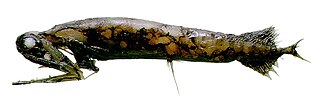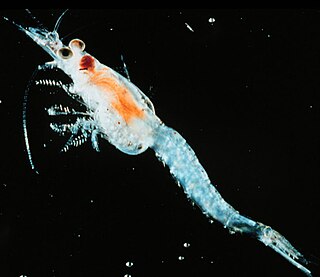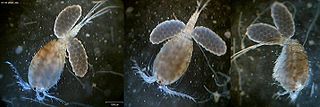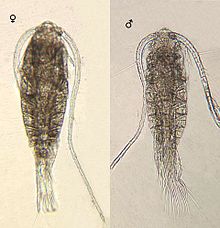
Zooplankton are heterotrophic plankton. Plankton are organisms drifting in oceans, seas, and bodies of fresh water. The word zooplankton is derived from the Greek zoon (ζῴον), meaning "animal", and planktos (πλαγκτός), meaning "wanderer" or "drifter". Individual zooplankton are usually microscopic, but some are larger and visible to the naked eye.

Copepods are a group of small crustaceans found in nearly every freshwater and saltwater habitat. Some species are planktonic, some are benthic, a number of species have parasitic phases, and some continental species may live in limnoterrestrial habitats and other wet terrestrial places, such as swamps, under leaf fall in wet forests, bogs, springs, ephemeral ponds, and puddles, damp moss, or water-filled recesses (phytotelmata) of plants such as bromeliads and pitcher plants. Many live underground in marine and freshwater caves, sinkholes, or stream beds. Copepods are sometimes used as biodiversity indicators.

Holoplankton are organisms that are planktic for their entire life cycle. Holoplankton can be contrasted with meroplankton, which are planktic organisms that spend part of their life cycle in the benthic zone. Examples of holoplankton include some diatoms, radiolarians, some dinoflagellates, foraminifera, amphipods, krill, copepods, and salps, as well as some gastropod mollusk species. Holoplankton dwell in the pelagic zone as opposed to the benthic zone. Holoplankton include both phytoplankton and zooplankton and vary in size. The most common plankton are protists.

Calanoida is an order of copepods, a group of arthropods commonly found as zooplankton. The order includes around 46 families with about 1800 species of both marine and freshwater copepods between them.

The deepwater sculpin is a freshwater sculpin that inhabits the bottoms of cold, deep freshwater lakes of northern North America. Its distribution ranges from the Great Bear Lake of Canada to the Great Lakes. It is a designated at-risk fish species in Canada, protected as a species of Special Concern under Canada's Species at Risk Act.

The rainbow smelt is a North American species of fish of the family Osmeridae. Rainbow smelt invaded the Great Lakes watershed through an intentional introduction of eggs in 1912, and from there has made its way to various other places. Walleye, trout, and other larger fish prey on these smelt. The rainbow smelt prefer juvenile ciscoes, zooplankton such as calanoid copepods, and other small organisms, but are aggressive and will eat almost any fish they find. They are anadromous spring spawners and prefer clean streams with light flow and light siltation. The rainbow smelt face several barriers. They are weak swimmers and cannot overcome most fish ladders. This prevents them from making it past the dams to the headwater streams where they spawn. The rise in erosion and dams helped to decimate the smelt population in the 1980s. There are currently plans to try to reduce damming and to help control erosion. With current efforts to reduce the human impact on this and many other affected species the population is back on the rise.

The deep sea fish, Malacosteus niger, is commonly known as the Black Dragon Fish. Some additional common names for this species include: Northern Stoplight Loosejaw, Lightless Lossjaw, Black Loosejaw, and Black Hinged-Head. It belongs to the order of fishes called the dragonfishes, or scientifically known as the Stomiidae. It is among the top predators of the open mesopelagic zone. M. Niger is a circumglobal species, which means that it inhabits waters ranging from the tropics to the subarctics. Not many studies have been conducted on its feeding habits, but recent research suggests that M. niger primarily feed on a calanoid copopods which is a form of zooplankton. Indeed, it appears that M. niger primarily prey on zooplankton despite its apparent morphological adaptations for the consumption of relatively large prey. Another unique adaptation for this species is its ability to produce both red and blue bioluminescence. Most mesopelagic species aren’t capable of producing red bioluminescence. This is advantageous because most other species cannot perceive red light, therefor allowing M. niger to camouflage part of itself to its prey and predators.

The bloody-red mysid, Hemimysis anomala, is a shrimp-like crustacean in the Mysida order, native to the Ponto-Caspian region, which has been spreading across Europe since the 1950s. In 2006, it was discovered to have invaded the North American Great Lakes.

Mysis is a genus of mysid crustaceans in the family Mysidae, distributed mainly in the coastal zone of the Arctic and high boreal seas. Several species also inhabit northern freshwater lakes and the brackish Caspian Sea. Fifteen species are recognized. Body lengths range from 1 to 3 centimetres.

Bythotrephes longimanus, or the spiny water flea, is a planktonic crustacean less than 15 millimetres (0.6 in) long. It is native to fresh waters of Northern Europe and Asia, but has been accidentally introduced and widely distributed in the Great Lakes area of North America since the 1980s. Bythotrephes is typified by a long abdominal spine with several barbs which protect it from predators.

The San Francisco Estuary together with the Sacramento–San Joaquin River Delta represents a highly altered ecosystem. The region has been heavily re-engineered to accommodate the needs of water delivery, shipping, agriculture, and most recently, suburban development. These needs have wrought direct changes in the movement of water and the nature of the landscape, and indirect changes from the introduction of non-native species. New species have altered the architecture of the food web as surely as levees have altered the landscape of islands and channels that form the complex system known as the Delta.

Forage fish, also called prey fish or bait fish, are small pelagic fish which are preyed on by larger predators for food. Predators include other larger fish, seabirds and marine mammals. Typical ocean forage fish feed near the base of the food chain on plankton, often by filter feeding. They include particularly fishes of the order Clupeiformes, but also other small fish, including halfbeaks, silversides, smelt such as capelin and goldband fusiliers.

Macrocyclops albidus is a larvivorous copepod species.
Acartia hudsonica is a species of marine copepod belonging to the family Acartiidae. Acartia hudsonica is a coastal, cold water species that can be found along the northwest Atlantic coast.

Mysis relicta is a shrimp-like crustacean in the Mysida order, native to lakes of Northern Europe and to the brackish Baltic Sea.

Mysis diluviana is a mysid crustacean found in freshwater lakes of northern North America.

Leptodora is a genus containing two species of large, nearly transparent predatory water fleas. They grow up to 21 mm (0.83 in) long, with two large antennae used for swimming and a single compound eye. The legs are used to catch copepods that it comes into contact with by chance. Leptodora kindtii is found in temperate lakes across the Northern Hemisphere and is probably the only cladoceran ever described in a newspaper; L. richardi is only known from eastern Russia. For most of the year, Leptodora reproduces parthenogenetically, with males only appearing late in the season, to produce winter eggs which hatch the following spring. Leptodora is the only genus in its family, the Leptodoridae, and suborder, Haplopoda.
Mysis salemaai is a shrimp-like crustacean in the Mysida order, inhabiting lakes of Ireland and South Scandinavia and brackish waters of the northern Baltic Sea.

Leptodiaptomus ashlandi is a calanoid copepod zooplankton native to the Laurentian Great Lakes and their basin.

Leptodiaptomus sicilis is a calanoid copepod native to the Laurentian Great Lakes and its basin.

















